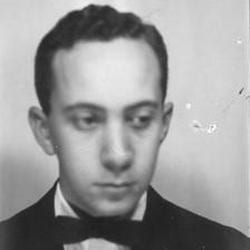José Serebrier, now a world-renowned conductor and composer, first came to prominence in 1953 when he won the Uruguayan National Orchestra’s annual music composition contest (SODRE) with his Legend of Faust overture, which the then fifteen year old composed in only four days. Within five years he had been honored with many of music’s most sought-after awards: a Koussevitzky Foundation Award in 1956, earned while a U.S. State Department Fellow studying with Vittorio Giannini at the Curtis Institute of Music and with Aaron Copland at Tanglewood; a BMI Young Composers Award that same year; and back to back Guggenheim Fellowships in music composition, in 1957 and 1958—the youngest person to ever receive a Guggenheim appointment.
During his years at the Curtis Institute (B.A., 1958) and the University of Minnesota (M.A., 1960), Mr. Serebrier continued to garner accolades and awards for his compositions, including a Pan American Union Publication Award for his Elegy for Strings, which conductor Leopold Stokowski premiered in New York at Carnegie Hall in 1962. In 1963 Maestro Stokowski again opened the American Symphony Orchestra’s season at Carnegie Hall with a Serebrier composition, this time Poema Elegiaco.
Leopold Stokowski and José Serebrier had first met in 1957, when the conductor chose Symphony No. 1, which Mr. Serebrier had composed at age seventeen while a student at the Curtis Institute, as a last-minute substitute for Charles Ives’ Symphony No. 4, which the Houston Symphony had found unplayable. Three years later, the maestro chose Mr. Serebrier as Associate Conductor of his American Symphony Orchestra in New York. In 1965, José Serebrier was one of two conductors at Leopold Stokowski’s side at the podium for the premiere of that difficult Ives composition, a piece so complex it required three conductors. However, a few years later Mr. Serebrier alone conducted the London Philharmonic Orchestra’s performance of Ives’ Symphony No. 1 to rave reviews; his recording of it with that orchestra (the first time he had recorded anything) was nominated for a Grammy award, the first of thirty-two he has received during the course of his career. He has won eight Grammy awards, including the Latin Grammy for "Best Classical Album of 2004” for his recording of the Carmen Symphony with the Barcelona Symphony Orchestra.
A native of Uruguay, Mr. Serebrier has composed over 100 pieces and is one of the most recorded classical artists ever, as both conductor and composer. Prior to his work with Leopold Stokowski, José Serebrier was Apprentice Conductor with Antal Dorati and the Minnesota Orchestra; after his four-year tenure with Mr. Stokowski he was appointed composer-in-residence of the Cleveland Orchestra (1968-69, 1969-70). In addition to the awards already mentioned, he has received commissions from the National Endowment for the Arts and Harvard University, and others too numerous to list.
It has been announced that Warner Classics and the Royal Scottish National Orchestra will conclude its Alexander Glazunov symphonic cycle with conductor José Serebrier this year. The Russian composer’s Symphonies 1, 2 and 3, as well as the unfinished Symphony Number 9 are forthcoming on Warner Classics later this year. The Orchestra’s Glazunov series under José Serebrier has earned kudos from critics around the world and all four recordings received Grammy nominations, in the categories of best orchestral performance and best recording of the year.
Follow the links below for more information concerning these recordings and their availability.
Warner Classics and Jazz
Royal Scottish National Orchestra
